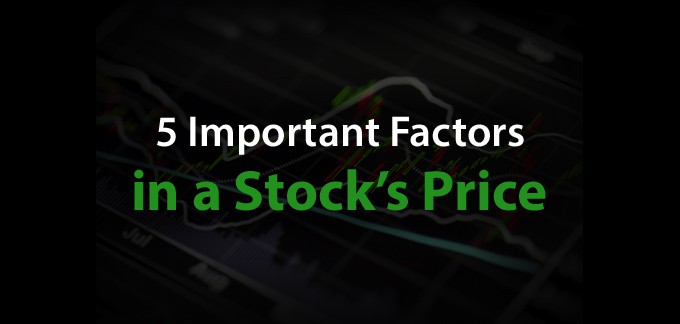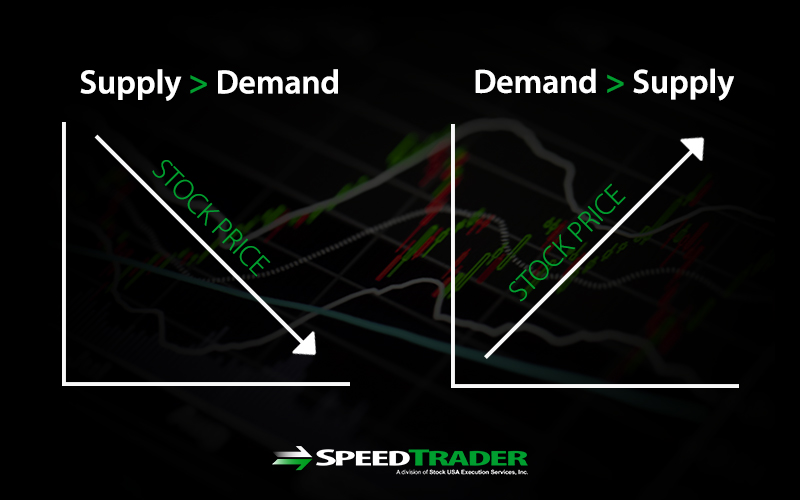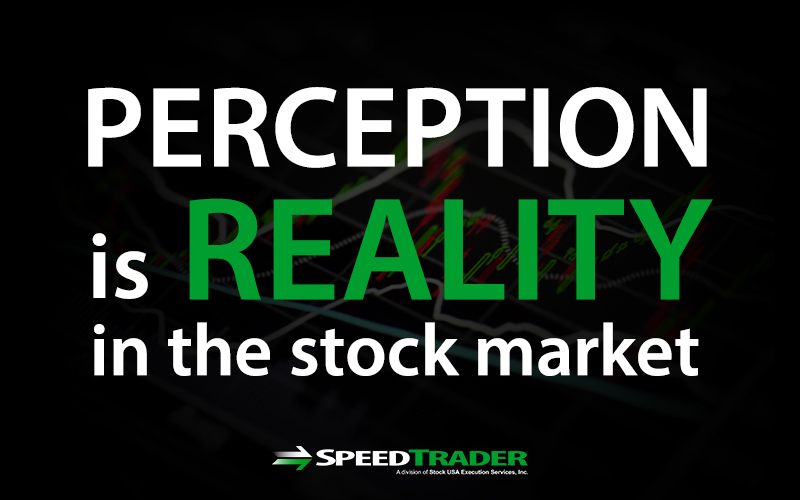Although there are plenty of factors that can affect a stock’s price, there are a few key things to focus on when analyzing price movement. There are five important factors that contribute to the pricing of any given publicly traded stock. Markets are forward thinking, therefore share price represents the forward value of a company. A solid understanding of these factors will help you to react prudently
1) Supply/Demand
The basic premise of stock pricing is based on supply and demand. If there is more demand with less supply, the shares should rise in value. On the flip-side, if there is more supply and thinning demand, the shares should fall in value.
Stock prices are represented by the bid and ask. Buyers represent the demand on the bid, left side of the quotes. Sellers represent the supply on the ask, the right side of the quote. The inside bid is the highest price a buyer is willing to pay and the size represents how much they are willing to buy. The ask, also known as the offer price, is the lowest price a seller is willing to sell and the size represents the number of shares they are willing to sell. Naturally, the bid and ask will fluctuate based on the remaining supply and demand. This is what makes a market in any financial instrument.
2) Float/Outstanding Shares
As mentioned above, supply and demand make the markets. The outstanding shares of a stock indicate the total issued supply of shares and the float represents the actual supply of the tradable shares. The float represents shares that are free trading and can be traded in the open market at any given time. The true trading float is the real mystery as there may only be a limited amount of buyers or sellers at any given time. When news or a fundamental catalyst is triggered, the trading float may expand or contract as each individual investor and fund has their own parameters for exiting or entering a position. During situations where volume expands dramatically, like an earnings miss or an FDA approval, the trading float may expand or contract just as dramatically.
Regardless, traders can determine a general range of shares available in a float. Stocks with low floats have a lower supply, therefore, it takes less demand to push the stock price up. Contrarily, if a stock has a large amount of shares in the float, there is a large supply, therefore, it can take a lot of buying power to have a significant impact on the stock’s price.
Stocks with thin floats tend to have more dramatic volatility and wider spreads, the difference between the inside bid and ask price. High priced stocks with heavy floats but thin trading shares can still move very quickly due to so much institutional ownership leaving a small tradable float.
3) Fundamentals
The fundamentals of a stock pertain to the financial performance of the underlying business. It serves to answer the age-old question of valuation: what is the intrinsic value of the company now and in the future? Although a company’s intrinsic value will not always align with its public valuation (stock price), it can still have an effect on supply and demand. For example, a company that appears to be undervalued, may have a higher demand. Therefore, there will be higher buying volume that can push the stock price up.
There are a variety of fundamental catalysts that can affect a stock.
Popular financial metrics used to quickly analyze and company valuation include price to earnings (P/E), price to sales (P/E), free cash flow, enterprise value and book value.
News releases can also be used to determine any material changes to the operations.
Earnings reports are released at the end of every quarter. The 10-K is the quarterly financial filing to the SEC. This report includes the financials for the prior quarter. Conference calls often accompany an earnings release to allow shareholders to ask questions and listen in on the presentation from the management. Future earnings guidance is what analysts and investors pay the closest attention to as that will make the most material impact on stock price.
4) Public Perception
Perception is reality in the stock market. Perception is what causes traders to make buying and selling decisions. The general perception of a stock can be summarized through sentiment. A stock with negative sentiment can be trading at a discount to its value, whereas a stock with very positive sentiment can be trading at a large premium. Sentiment can be influenced when industry and sector leaders make the news.
Bearish Sentiment
For example, when the public perception turned sour on pharmaceutical stocks due to the sharp increase in certain medication prices, sentiment turned bearish. This has resulted in weak price performance. The media spurred Congress to further investigate drug-pricing practices, which continues to depress pharmaceutical companies.
Bullish Sentiment
On the other hand, certain blue chip stocks can maintain an abnormally high P/E ratio (when compared to the industry average) due to extremely positive sentiment. This bullish sentiment continues to fuel shares of certain stocks to new highs.
5) Industry Standards
The stock market is composed of sectors like healthcare, information technology, consumer discretionary and so forth. Sectors are composed of various industries. As mentioned above, perception plays a big role in a stock’s price and money flow tends to gravitate towards ‘hot’ sectors and notably ‘hot’ industries within the sector. Industry specific standard financial metrics can be used to compare stocks amongst peers.
Average P/E
Price/earnings is a widely used metric employed by mutual funds to small investors. You can find the average P/E by looking up the most widely traded ETF(s) for that particular sector or industry. For example, if a sector has an average P/E of 20.49, this can be used as a benchmark for companies within the industry.
Industry Trends
The performance of industry leader stocks tends to indicate the overall trend and sentiment for the industry. Media coverage, government legislation, catalysts and themes tend to shape the fundamental industry trends. As some industries are perceived to be growing while others are perceived to be dying.
Growing and Shrinking Industries
The overall health of a particular industry/sector can play a role in the success of specific stocks within that industry. For example, cyber defense is a growing industry that makes the news with every large-scale hacker attack or security breach. This means that certain stocks in this industry may do well simply because of the sector strength.
Contrarily, the private for-profit prison industry is a dying industry as the United States Justice Department and Congress has made their intentions clear on phasing out these contracts. Certain stocks in this industry may perform poorly due to the sector weakness.
Life Cycle
Start-up companies in the early business life cycle can experience hyper growth well above 25% quarterly sales growth. Top line sales growth is the favored growth metric as the company grows market share at the cost of profits. Eventually, profit growth comes to the forefront as a company matures. When a company achieves consistent top and bottom line growth trajectory, it can eventually become an industry leader. The most exceptionally consistent companies eventually become sector and index benchmarks in due time. These are traditionally the most widely owned and traded stocks.




